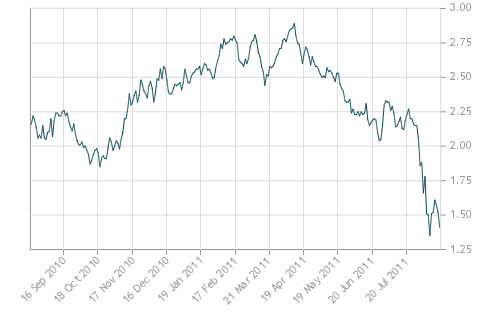In what promises to be a less exciting week coming up in the market as it continues its summer doldrums, market participants should be aware that most of the brains behind the heavy money funds will be on vacation in August.
It would not surprise me in the least to see some sort of bounceback in the S&P 500 to levels about 5% higher than here, but there are larger undercurrents going on that may continue having the computer traders pound anything that is offering liquidity – mainly the well-known European sovereign debt crisis.
Back in 2008 when Bear Stearns, Merrill Lynch and Lehman Brothers were collapsing, everybody knew what was causing the financial crisis, but nobody had a clue when the damage would stop – in this case, it was in March 2009 when the ultimate lows were reached. I suspect that something like this will be happening again, but it is difficult to tell whether it will be a few months after a main triggering event, or even a few years.
Either way, the root cause of most financial problems stem from debt and leverage. Right now, the problem is that certain banks assumed that their assets (debt in less than reputable soverign nations) were worth as much as they are on their balance sheets, but ultimately they are not.
Looking a little less globally, when less knowledgeable people listen to their “financial advisors” and borrow money at prime (3%) to invest in some bond or index fund which will make them a “long term stable return” of 6%, they will also discover the urge for liqudiation when their leverage factor imparts huge losses on their net worths.
I do not believe it is time to start buying things yet, but the valuations look compelling. Rather, now is the time to research things that will be worth buying when the market decides to take another deleveraging-induced dive.
Something I have consistently found puzzling is that there are a variety of companies that are selling under projected P/Es of 10, which makes them seem infinitely more attractive than the 10-year government bonds that are giving out a yield of 2.24%. Just to use an arbitrary example of Dell (Nasdaq: DELL), we have a company that has a market cap of $28 billion, about $7 billion net cash on the balance sheet, and for the past two years has generated about $3.5 billion in free cash flow (about $1.87/share) and trading at a stock price of $14.87, or roughly 8 times free cash flow generation.
What the bond market is effectively betting is that companies like Dell aren’t going to make as much money as they have been, or that the risk premium afforded to common shares of Dell is quite high. It is not like the company is in the pharmaceutical industry where you have to worry about patent expirations and other time-sensitive risk. It is quite difficult to conceive of scenarios where you would see the diminution of the business – perhaps Amazon will compete? An investor would have to answer this question in order to consider owning the stock, otherwise they are playing poker without looking at their own cards.
